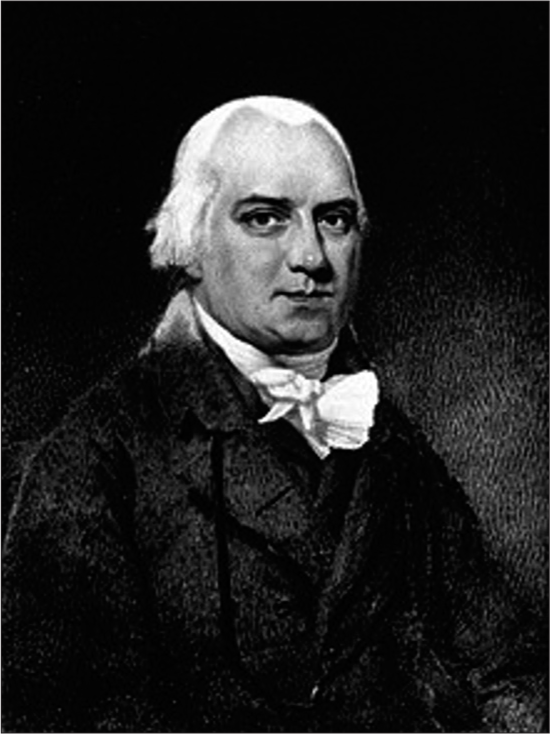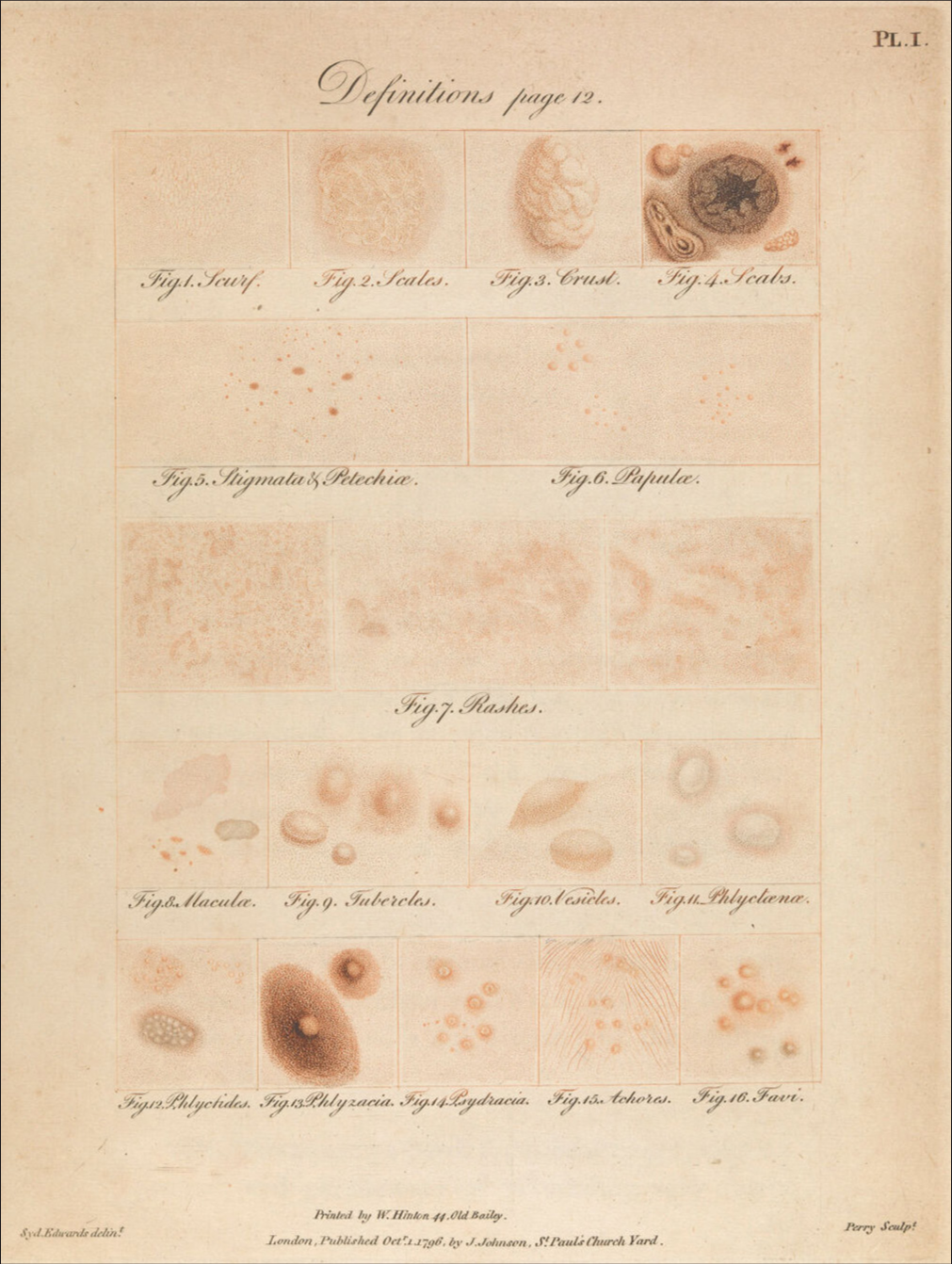Translate this page into:
Robert Willan: Pioneering systematic dermatological classification and advancing modern dermatology

*Corresponding author: Vishal Gaurav, Department of Dermatology and Venereology, Maulana Azad Medical College, New Delhi, India. mevishalgaurav@gmail.com
-
Received: ,
Accepted: ,
How to cite this article: Patel V, Gaurav V, Rao A, Yadav D, Barman KD. Robert Willan: Pioneering systematic dermatological classification and advancing modern dermatology. CosmoDerma. 2025;5:2. doi: 10.25259/CSDM_193_2024
Robert Willan (1757–1812) is widely acknowledged as a pioneering figure in the development of modern dermatology [Figure 1].[1,2] His influence is still felt in the field today, particularly through his systematic approach to the classification and study of skin diseases.[1] Willan’s contributions were groundbreaking; he was the first to systematically classify skin diseases based on their morphological characteristics, replacing the inconsistent and often erroneous methods used before his time.[3,4]

- Robert Willan (1757– 1812) (Credits: Reproduced from A.C. Cooper/Wikimedia Commons/Public domain. Permission is not required as the source is under a creative commons license in public domain).
Robert Willan was born on November 12, 1757, in Hill, a small village near Sedbergh in Yorkshire, England. Willan was a Quaker, and the Society of Friends had long been dedicated to philanthropic endeavors and the well-being of others.[5] Willan’s early education took place at Sedbergh School, one of England’s prominent grammar schools, where he excelled in classical studies and mathematics. His intellectual development was further guided by John Dawson, a brilliant mathematician who helped cultivate Willan’s analytical skills and deep appreciation for systematic thinking.[5] In 1777, Willan began his medical studies at the University of Edinburgh, renowned for its rigorous curriculum and distinguished faculty. Influential figures such as William Cullen, a pioneer in disease and classification, and Alexander Monro, a celebrated anatomist, played pivotal roles in shaping Willan’s approach to medicine.[4-8] These mentors instilled in him the importance of systematic classification and observation, principles that would later become the cornerstone of his work in dermatology.[4,8] His early exposure to the challenges faced by the poor and underserved populations of London deeply influenced his commitment to bringing order to the chaotic field of skin disease treatment, which he addressed throughout his career.[9,10]
Willan’s systematic approach to dermatology was revolutionary, as he sought to categorize and document skin diseases based on observable characteristics rather than speculation or superficial similarities. His groundbreaking work at the Carey Street Dispensary in London exposed him to a wide range of skin conditions among the poor, providing him with a wealth of clinical material to study.[9,11] This experience led to his first major contribution: The classification and documentation of skin diseases. Willan outlined his objectives for creating a new classification system in the introduction to “On Cutaneous Disease” [Figure 2].[12,13] His goals included:

- “Definitions” of lesions (Credits: Reproduced from Wellcome Library/CC BY 4.0./Public domain. Permission is not required as the source is under a creative commons license in public domain).
Establishing clear definitions to ensure consistent use of terminology
Creating general categories for diseases based on their distinctive features, organizing them into genera, and providing detailed descriptions of their specific forms or varieties
Identifying and naming diseases that have not been adequately classified
Providing treatment recommendations for each identified disease.[12,13]
Willan’s classification system was heavily influenced by the Linnaean taxonomy used in botany, which organized plants based on their characteristics.[3,6] Applying this method to dermatology, Willan introduced a systematic approach that categorized skin diseases into eight distinct orders: papulae, squamae, exanthemata, bullae, pustulae, vesiculae, tubercula, and maculae.[1] Each class was further divided into genera. For instance, the Squamae class encompassed four genera: Lepra, Psoriasis, Pityriasis, and Ichthyosis. These genera were then subdivided into various species, such as Pityriasis, which included capitis, rubra, and versicolor. Willan’s work was comprehensive, with the complete text spanning 566 pages and featuring 36 color plates.[1] This innovation brought much-needed order to the study of skin diseases and laid the groundwork for future advancements in the field. Willan’s meticulous documentation, which included detailed descriptions and classifications, allowed for more accurate diagnoses and better communication among physicians. This nomenclature was designed to be both descriptive and functional, making it easier for physicians to identify and treat various skin conditions.[14] Willan’s work was critical in establishing dermatology as a distinct medical specialty, separate from general medicine, and recognized as an important field of study in its own right. Among Willan’s, most notable publications is his seminal work, on cutaneous diseases, published in parts between 1798 and 1808.[10,13] This comprehensive text provided detailed descriptions and illustrations of the various skin diseases he had classified.[15] The work was a milestone in dermatology and a significant contribution to medical literature as a whole [Table 1]. Willan’s emphasis on using visual aids, such as hand-colored plates, to accompany his descriptions was particularly innovative, highlighting his understanding of the importance of accurate visual representation in medical education and practice.[15]
| Year | Milestone |
|---|---|
| 1757 | Born on November 12 in Hill, near Sedbergh, Yorkshire, England, into a Quaker family |
| 1777 | Began medical studies at the University of Edinburgh, a leading institution in medical education |
| 1780 | Graduated with an M.D. degree from the University of Edinburgh |
| 1783 | Appointed as a physician to the Carey Street Public Dispensary in London, serving the poor |
| 1790 | Presented his first classification of skin diseases to the Medical Society of London |
| 1798 | Published the first part of his seminal work, On Cutaneous Diseases, marking the start of a systematic classification of skin diseases |
| 1800 | Moved to Bloomsbury Square, London, where he continued his medical practice and research |
| 1808 | Completed and published the final part of On Cutaneous Diseases, establishing a comprehensive taxonomy for dermatology |
| 1811 | Due to deteriorating health, left London to recuperate in Madeira |
| 1812 | Died on April 7 in Madeira, Portugal, at the age of 54, from tuberculosis |
Robert Willan’s approach to clinical observation and documentation revolutionized dermatology, setting new standards in the field. His work was marked by meticulous attention to detail, especially in describing skin lesions and their progression.[8] Willan’s methodology involved repeated and careful observation of patients over time, allowing him to accurately document the natural history of various skin diseases. This method was not solely focused on classification but also on understanding the underlying patterns and behaviors of skin conditions, which were essential for improving diagnosis and treatment.[14] Willan introduced a more scientific approach, emphasizing the importance of morphological features in the diagnostic process. This methodology allowed for more precise identification of conditions, enabling more targeted and effective treatments. His focus on morphology also laid the foundation for future developments in dermatopathology, further solidifying his influence on the field.[1,15] Willan’s influence extended beyond his lifetime, profoundly impacting subsequent generations of dermatologists. His systematic approach was adopted by contemporaries and successors, particularly Thomas Bateman, who expanded on Willan’s work after his death.[9,11] Bateman and others refined and built on Willan’s classifications, maintaining the rigorous observational methods that he had established. Bateman’s “Delineations of Cutaneous Diseases” ensured that the principles of accurate observation and classification were passed down, helping to elevate dermatology to a respected medical specialty influencing practices in the UK and beyond.[9-11] Furthermore, Willan’s methodologies influenced medical education, particularly in dermatology training. His works were widely used as educational tools, and his emphasis on detailed documentation and visual aids became standard in dermatological training.
Willan’s legacy is evident in how dermatology has been taught and practiced over the centuries, with many of his methods still in use today. Through his methodical approach and innovative practices, Robert Willan transformed dermatology, setting a precedent for studying, documenting, and treating medical conditions. His contributions laid the foundation for the scientific approach that continues to underpin dermatology, ensuring his influence endures for generations. Legacy and Recognition Posthumously, Robert Willan has received various accolades, including the title of “Dermatologist of the Millennium,” underscoring his lasting influence.[9] His legacy is celebrated through the Willan Room at the Royal College of Physicians, a blue plaque at his Bloomsbury Square residence, and the British Association of Dermatologists’ library named in his honor.[16,17] These tributes not only recognize his significant contributions but also ensure his enduring impact on dermatology. Willan’s classifications and methodologies remain relevant in modern practice, demonstrating the lasting value of his systematic approach to skin diseases.
Robert Willan’s work in dermatology places him among the most influential medical pioneers of his time. While contemporaries such as Edward Jenner made groundbreaking strides in immunology with the smallpox vaccine, Willan revolutionized the understanding and treatment of skin diseases.[4,12] Thomas Bateman (1778– 1821) was Willan’s most dedicated student at the Dispensary, eventually becoming both a close friend and collaborator.
In a biographical memoir, Bateman reflects on their relationship and shared work: “We are unacquainted with the circumstances which originally drew the attention of Dr. Willan to the subject of cutaneous diseases. Most probably his own extreme accuracy made him feel early and acutely the vagueness and confusion of language, which universally prevailed in this department of medicine, while his attendance at a public institution brought many of these diseases constantly under inspection.”[6]
Robert Willan’s work was pivotal in establishing dermatology as a distinct medical field marked by systematic classification and scientific precision. He was a pioneer in categorizing skin diseases, creating a standardized dermatological terminology, and meticulously documenting cases, laying the groundwork for modern practices. His methodologies continue to influence clinical practice and medical education, solidifying his legacy as the father of modern dermatology. Willan’s contributions remain foundational, inspiring future generations of medical professionals and leaving a lasting impact on the field of dermatology and broader medical disciplines [Table 2].
| Achievement | Description |
|---|---|
| Appointment at Carey Street Public Dispensary (1783) | Began documenting and studying skin diseases while serving underserved patients in London |
| Classification of Skin Diseases (1790) | Introduced a systematic classification based on morphology to the Medical Society of London |
| Publication of On Cutaneous Diseases (1798–1808) | Authored a seminal eight-category classification system, establishing a scientific foundation for dermatology |
| Development of Dermatological Nomenclature (1790s–1800s) | Standardized terms like “psoriasis,” “lichen,” and “impetigo,” still used today |
| Use of Detailed Illustrations (1798–1808) | Pioneered hand-colored plates in medical texts, enhancing diagnostic precision and education |
| Fellowship at the Royal Society (1809) | Recognized for his contributions by election to this prestigious scientific body |
| Establishment of Dermatology as a Specialty | Elevated dermatology to a distinct medical discipline through his innovations and systematic methods. |
| Posthumous Influence (1812 and beyond) | His works shaped modern dermatology, influencing figures such as Thomas Bateman and the global field |
Ethical approval
The Institutional Review Board approval is not required.
Declaration of patient consent
Patient’s consent was not required as there are no patients in this study.
Conflicts of interest
There are no conflicts of interest.
Use of artificial intelligence (AI)-assisted technology for manuscript preparation
The authors confirm that there was no use of artificial intelligence (AI)-assisted technology for assisting in the writing or editing of the manuscript and no images were manipulated using AI.
Financial support and sponsorship
Nil.
References
- Robert Willan: Pioneer in morphology. Clin Dermatol. 2011;29:125-9.
- [CrossRef] [PubMed] [Google Scholar]
- Robert Willan. Wikimedia Commons. Available from: https://commons.wikimedia.org/wiki/File:Robert_willan.jpg [Last accessed on 2024 Nov 07]
- [Google Scholar]
- A note on Robert Willan's Edinburgh days. Br J Dermatol. 1973;88:615-7.
- [CrossRef] [PubMed] [Google Scholar]
- Robert Willan, M.D., F.R.S., F.S.A. Br J Dermatol. 1968;80:459-68.
- [CrossRef] [PubMed] [Google Scholar]
- Robert Willan: A Quaker physician who founded the morphologic approach to modern dermatology. Clin Dermatol. 2011;29:567-70.
- [CrossRef] [PubMed] [Google Scholar]
- The founders of dermatology: Robert Willan and Thomas Bateman. J R Coll Physicians Lond. 1999;33:580-2.
- [Google Scholar]
- Robert Willan and the age of enlightenment. Int J Dermatol. 2008;47:297-300.
- [CrossRef] [PubMed] [Google Scholar]
- Robert Willan MD: FRS (1757-1812): Dermatologist of the millennium. J R Soc Med. 1999;92:313-8.
- [CrossRef] [PubMed] [Google Scholar]
- Robert Willan-dermatologist and humanist extraordinaire. JAMA Dermatol. 2017;153:29.
- [CrossRef] [PubMed] [Google Scholar]
- Robert Willan: The solution of a ninety-year-old mystery. J Hist Med Allied Sci. 1957;12:349-65.
- [CrossRef] [PubMed] [Google Scholar]
- On cutaneous diseases. Wellcome Collection. Available from: https://wellcomecollection.org/search/images?query=dmu5k2gq# [Last accessed on 2024 Aug 15]
- [Google Scholar]
- Remembering Robert Willan: How one man forever changed the way we approach skin diseases. J Am Acad Dermatol. 2023;88:67-9.
- [CrossRef] [PubMed] [Google Scholar]
- Robert Willan and the French Willanists: Robert Willan and the French Willanists. Br J Dermatol. 1999;140:1122-6.
- [CrossRef] [PubMed] [Google Scholar]
- A tribute to Robert Willan in Bloomsbury square: Historical vignette. Clin Exp Dermatol. 2011;36:695-6.
- [CrossRef] [PubMed] [Google Scholar]
- Robert Willan and the history of dermatology. Available from: https://history.rcplondon.ac.uk/blog/robert-willan-and-history-dermatology [Last accessed on 2024 Aug 15]
- [Google Scholar]






